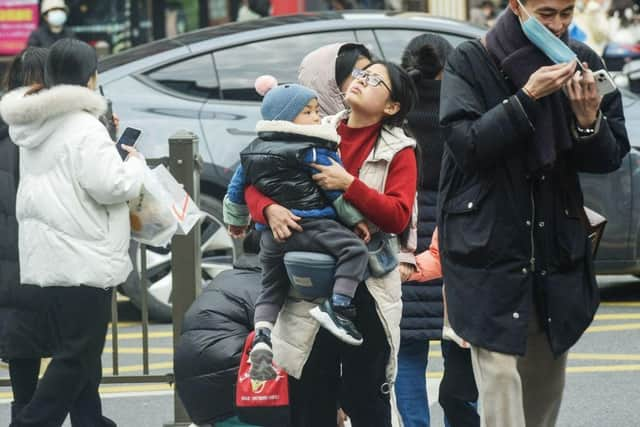China depopulation: Twenty-year-old 'zero population growth' aim comes to fruition - but at what cost?
"Achieve zero population growth in 2022”, heralds the front page of the Qilu Evening News in the province of Shandong, above an article detailing Chinese authorities’ “strategic goals for population and family planning work”.
Unlike many ambitious government targets around the globe, this one has now been met. For the first time in 60 years, official figures from Beijing have shown the population in China fell by 850,000 from 2021 to 1.4118 billion last year.
Advertisement
Hide AdAdvertisement
Hide AdThe figures mean deaths have outnumbered births in China for the first time since the Great Leap Forward – the economic experiment spearheaded by Mao Zedong in the 1960s, which resulted in one of the largest famines in human history and the deaths of tens of millions of people.
However, Beijing may not be celebrating in the way the officials who created the target in 2002 may have believed it would.
As many Western countries have been experiencing for some time, China is soon to feel the effects of an ageing population – with a growing number of retired elderly people who require investment in healthcare – coupled with a low birth rate and a smaller number of economically productive workers. Although China’s controversial One Child Policy, which banned many families from having more than a single child, was scrapped in 2015, the birth rate in the country is still just 1.18 children per women – a figure the UN says will only rise to 1.48 in 2100. A birth rate of 2.1 is generally cited as necessary for a country to have a stable population.
Yi Fuxian, a demographer and expert on Chinese population trends at the University of Wisconsin-Madison, said China's real demographic crisis was “beyond imagination”, adding all of the country’s past economic, social, defence and foreign policies were “based on faulty demographic data".
"China has become older before it has become rich," Mr Yi said. He said China now had one of the lowest fertility rates in the world, comparable only to Taiwan and South Korea.


China's population had begun to decline nine to ten years earlier than Chinese officials or the UN originally predicted, Mr Yi added.
According to the latest UN projections published at the end of last year, China’s population will drop to 1.313 billion by 2050 and to less than 800 million by 2100.
It has long been the world’s largest country in terms of population, but is set to be overtaken by India later this year. It has had the largest population in the world since at least 1950, when United Nations records began.
Advertisement
Hide AdAdvertisement
Hide AdThe One Child policy, rolled out in 1980 by Deng Xiaoping, was regarded at one time as a driver of economic growth, after the population appeared to be ballooning out of control. Most families were restricted to having only one child, with forced abortions and fines faced by those who violated the rules. People who worked for the state were also at risk of losing their jobs if they broke the rules.
The policy also led to a chilling rise in both gender-selective abortions and infanticides of girls, as some families demonstrated a preference for a male single child. The population of men in China still far outnumbers that of women as a result.
China’s National Health and Family Planning Commission has claimed over the years the policy was implemented, the number of births had been reduced by as many as 400 million.
China’s economic performance has been transformative over the past four decades, moving from one of the world’s poorest countries into an economic powerhouse, with consistently high annual growth. However, the pandemic – and leader Xi Jinping’s stringent Zero Covid policy, which has only been scrapped in the past few weeks – has seen growth slow dramatically.
Now, however, the Chinese government has tried to encourage families to have more children in a bid to increase the working population. A two-child policy has quickly become three, with Beijing announcing at the end of May 2021 it would allow each couple to have three children. In some areas, incentives have been brought in to encourage births. In Shenzhen, a couple who has their first baby will automatically receive 3,000 yuan (£360) – an amount that rises to 10,000 yuan for their third.
However, some demographers believe it is too little, too late.
"It’s unquestionable that China will not see population growth from now on, as an endless period of population decline began in 2022,” independent demographer He Yafu told Chinese media. “There’s no hope that the decline can be reversed.”
Yet some economists believe the population decline will not have a major impact on China’s economic growth. Figures also released by Beijing showed the Chinese economy expanded at its slowest pace since the mid-1970s – except the first year of Covid pandemic – in the fourth quarter of last year. However, the 3 per cent rise was still above the 2.7 per cent predicted by the World Bank earlier this month.
Advertisement
Hide AdAdvertisement
Hide AdRobert Gilhooly, senior economist at Edinburgh-based Abrdn, pointed to relatively gradual population decline forecast over the next ten years, with the true fall occurring after 2045.
He said the impact on economic growth would be “fairly modest”, adding: “What matters most is the combination of the quality and quantity of workers for GDP growth. China has scope to further raise human capital and our growth decompositions imply that rising quality will more than offset China having fewer workers until 2040. The productivity of China’s workforce also has a long way to go to catch up too – in ten years’ time GDP per capita will still only be a quarter of the that of the US.
“Demographics is not destiny for economic growth.”
Comments
Want to join the conversation? Please or to comment on this article.